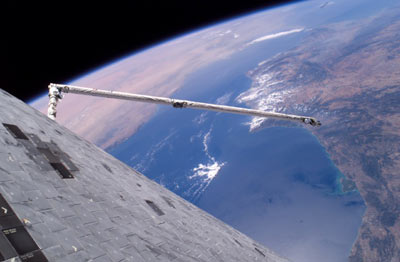Canadian robotics and the future of space explorationby Sumitra Rajagopalan
|
| In the new era of space travel, the Canadian space community is in a position to project a vision for the future—one where astronauts will join forces with intelligent robots to probe the solar system. |
Back in the day, when the shuttle was a mere drawing on the board, Canada volunteered to build a robotic arm that would serve as a workhorse, and help astronauts with challenging and risky tasks in space. Since its first launch in 1981, the arm and its successors have been indispensable to astronauts by carrying out a range of tasks, including releasing payloads from the cargo bay, assembling the space station and dragging errant satellites back into the right orbit. The Canadarm was also called upon to give the astronauts a helping hand to fix the prized Hubble telescope.
Now engineers at the Canadian Space Agency (CSA) are looking beyond the Canadarm to build the next generation of space robots to gear astronauts for missions beyond the confines of Earth’s orbit. As a first step toward making space robots smarter, engineers at the CSA have built a reactive engine called the Cortex. This software allows space robots to react instinctively and intuitively to any disturbances without seeking a lifeline from Earth. Think robot with reflexes. There is another quirky contraption in the works at the CSA: a self-reconfiguring robot, one that can mould its body like a contortionist on command. These robots could easily get into nooks and cracks when building and assembling spacecraft in space.
In the new era of space travel, the Canadian space community is in a position to project a vision for the future—one where astronauts will join forces with intelligent robots to probe the solar system. Riding on the legacy of the Canadarm, Canadians can definitely take on a leading role in this endeavor.
Sadly, I don’t see that happening just yet. For all their technological prowess, there is one thing that is sorely lacking among Canada’s leading space engineers: poetry. Long before anyone set foot into outer space, engineers had already built shuttles, space stations and Mars colonies—in their dreams. At a time when rocket technology was still in its infancy, there were great minds who, armed with little more than basic physics and oodles of imagination, came up with magnificent visions of spaceflight, many which live on till today.
Wernher von Braun was one such visionary. Considered the father of the US space program, von Braun unveiled his vision of a future manned mission to Mars in a novel called The Mars Project. Here, he wove eloquent fiction with engineering precision to describe a glider that would ferry humans to the surface of the Red Planet.
Then there is was Konstantin Tsiolkovsky—the father of Russian rocketry—whose poetic musings on man’s future in space went on to become the guiding light for the Soviet space program.
Where are those free thinkers and poets today? Where are the scientists with a vision to inspire us? Certainly not at the Canadian Space Agency. While undoubtedly home to brilliant engineers, the CSA doesn’t seem to strike the right chord with the public. For all its public relations efforts, its vision for Canada’s future in space remains painfully prosaic. Its message is supposed to make our spirits soar, but ends up falling flat on its face.
| IWhile undoubtedly home to brilliant engineers, the CSA doesn’t seem to strike the right chord with the public. For all its public relations efforts, its vision for Canada’s future in space remains painfully prosaic. |
My humble advice to my colleagues and friends at the CSA: Take a cue from the Russian cosmonauts. Remember Sergei Avdeev talking about his stint on the space station? His voice quivered as he spoke of the need to explore distant worlds. His message was as much about science as it was about the arts, literature, philosophy and the human spirit. He must have quoted at least 20 writers and poets during his hour-long talk. That was the first—and last—time that I left the CSA with goosebumps all over.
The spectacular success of the Canadarm aboard Discovery has CSA president Marc Garneau and his team beaming and bragging with pride—and understandably so. With Canadian space technology once again in the spotlight, this is a golden opportunity for the CSA’s charismatic astronaut corps to put forward and promote a bold vision for the Canadian human spaceflight program—one where man will forge a partnership with machines as he ventures towards the moon, Mars, and beyond.
